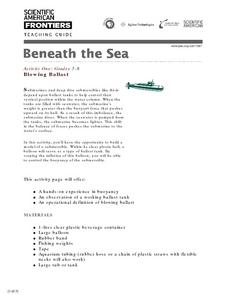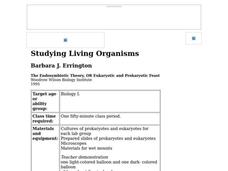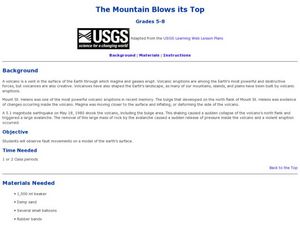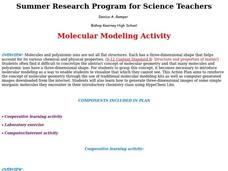Curated OER
Organic Matter in Soils
Students recognize the presence of organic matter in soils from their immediate area and recognize which soil sample contains the highest concentration of organic matter.
Curated OER
Weather or Not (Cloud Formation/Condensation)
Students investigate the formation of clouds and rain in this experiment. They decide how dust in the air helps to make clouds form and how dust helps meteorologists make forecasts.
Curated OER
Earth Matters
Students identify Earth's equator, prime meridian, lines of latitude, lines of longitude, parallels, and meridians.
Curated OER
Beneath the Sea
Students build a model of a submersible that will allow them to explore ballasts and how they operate. In this hands on lesson students participate in an activity that shows them how to control buoyancy.
Curated OER
Convection in a Pan
Students explore convection. For this lesson on heat and energy, students investigate how heat moves in convection currents. They use their finding to better understand how convection currents effect the movement of tectonic plates.
Curated OER
Static Electricity Game
Fifth graders explore further the importance of static electricity by playing a game which reinforces and reviews static electricity concepts.
Curated OER
Opposites Attract
Students examine the properties of magnets and static electricity. They participate in experiments that demonstrate the behaviors of charged particles, and record their data on a worksheet.
Curated OER
Studying Living Organisms
Students are introduced to Hardy-Weinberg Equilibrium without recourse to algebra. After participating in this activity, students gain a feeling for the significance of the Hardy-Weinberg Equilibrium without using algebra.
Curated OER
Investigating Motion
Students explore types of motion. In this motion experiment, students observe how objects move. Students work in small groups to discover the laws of motion.
Curated OER
How is Lightning Formed
Students research lightning paying particular attention to how it is formed, where it is most likely to occur, and how most people struck by lightning survive.
Curated OER
How Can we Measure the Rate of a Chemical Reaction?
Pupils examine different types of chemical reactions. They explore how alcohol molecules affect the reaction rates. They answer discussion questions to end the lesson.
Curated OER
Hot Gas Or Cold Gas Lab
Students engage in a lab project to study chemical reactions. They use guided questions to help facilitate the lab experience and come to the correct outcomes. The lesson does not contain a true understandable objective. The lesson could...
Curated OER
Weather
Students read a weather map. Using the local newspaper, Columbus Dispatch, small groups investigate that air has pressure and that temperature and pressure are inversely related in weather. They display their findings on a graph or...
Curated OER
The Circulatory System
Pupils explore the circulatory system of animals. Using the Internet, students research animals without circulatory systems. They identify the three types of blood vessels and describe the flow of blood through the heart. Finally, pupils...
Curated OER
The Mountain Blows its Top
Students replicate a volcanic eruption. In this volcanoes lesson, students follow the provided procedures to show and describe how the inflation of a bulge led to the eruption of Mount St. Helens.
Curated OER
Making Thunderstorms
First graders investigate the causes of thunderstorms and create the sounds of a thunderstorm.
Curated OER
Air Pressure
Students get a better understanding of air pressure and how it effects our daily lives.
Curated OER
Weather Art in Space Settlements
Students demonstrate a cloud formation and the relation between pressure and temperature in gases. They explain how clouds could be created in space settlements and see the relation between pressure and temperature in gases.
Curated OER
Sculpt-a-Planet
Students study the moon and the planets. They create a painted, paper mache moon or planet sculpture.
Curated OER
Molecular Modeling Activity
Students work together to explain the VSEPR theory and how it relates to molecules. They name electron pairs that can surround the central atom of an organism. They discuss the factors that determine the polarity of a molecule as well.
Curated OER
Physical Changes and States of Matter- Two
Third graders explore the concept of evaporation as they observe how the water level changes in a cup that is left out. Working in groups they observe physical changes in a group of everyday items. They record the changes in shape, size,...
Curated OER
Water Quality Tests Explained
Students define all eight water quality parameters and list at list one source for each of the eight water quality parameters. They determine how each of the eight parameters affect river ecosystems.
Curated OER
Solids, Liquids, and Gases
Learners explore solids, liquids, and gasses and categorize and describe the three states of matter. For this chemistry lesson, students categorize items as solid, liquid, or gas based on the definitions given by the teacher. Learners...
Curated OER
Ideal Gas Law Worksheet
In this ideal gas law worksheet, students complete 8 problem solving questions to find pressure, volume and temperature of given gases.























